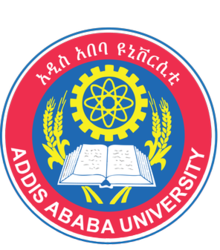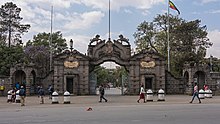Addis Ababa University
አዲስ አበባ ዩኒቨርሲቲ | |
 | |
Former names | University College of Addis Ababa (1950–1962) Haile Selassie I University (1962–1975) |
|---|---|
| Type | State university |
| Established | 1950 |
| President | Professor Tassew Woldehanna[1] |
| Students | 48,673 (2013/14)[2] |
| Location | Addis Ababa , Ethiopia |
| Campus | Addis Ababa (14 campus, including main) |
| Language | English |
| Website | aau.edu.et |
Addis Ababa University (AAU) (Amharic: አዲስ አበባ ዩኒቨርሲቲ) is a large, highly residential national university in Addis Ababa, Ethiopia. The university is the oldest school of higher education in Ethiopia. AAU has thirteen campuses. Twelve of these are situated in Addis Ababa, and one is located in Bishoftu (Debre Zeit), about 45 kilometres (28 mi) away. AAU has several associated research institutions including the Institute of Ethiopian Studies. The Ministry of Education admits qualified students to AAU based on their score on the Ethiopian Higher Education Entrance Examination (EHEEE).
Contents
1 History
1.1 Administration
1.2 Influence
2 Campuses and colleges
2.1 Colleges
2.2 Research and Teaching Institutes
2.3 Schools
3 Notable alumni
3.1 Prime Ministers
3.2 Physicists
3.3 Historians
3.4 Biologists
3.5 Engineers
3.6 Chemists
3.7 Anthropologists
3.8 Authors
4 References
5 External links
History

Front entrance to Addis Ababa University.
The origins of AAU was a two-year college in 1950 by Dr Lucien Matte, S.J., at the appeal of Atse Haile Selassie I.[3] It began operations the following year. Over the following two years an affiliation with the University of London was developed.
The nucleus of AAU was formed with the establishment of the University College of Addis Ababa (UCAA) in 1960.[4] UCAA, which initially consisted of the Faculties of Arts and Science, became a fully fledged college when it was chartered in 1954. In 1955, the Building College was opened. In February 1961, these various colleges and the Theological College were brought together to form the Haile Selassie University. Atse Haile Selassie I gave his Guenete Leul Palace to serve as the administration building and main campus. He had abandoned the palace, where a number of his ministers and favorites were killed in the wake of the abortive Coup d'état in 1960, in favor of the new Jubilee Palace.[5] Following the 1974 revolution, the university was briefly renamed University of Ethiopia (National University) before it came to assume its present designation, AAU, in 1975.[6] In the wake of the revolution, AAU was closed for two years and students and staff were drafted into what was known as the Development through Cooperation Campaign (zemecha), designed to arise the awareness of the rural population in the spirit of the revolution.[7] The university offered its first Master's programs in 1979 and its first PhD programs in 1987.[8]
Administration
Until 1974 the charter provided for a governance structure in the following descending order or authority: Chancellor (the Emperor himself); the Board of Governors, composed of ministers and members of the royal family; and the Faculty Council, made up of the university officers, deans, directors and elected members. The Faculty later became the Senate. In 1977, the AAU lost its relative autonomy when it was brought under the Commission for Higher Education, which came to exercise administrative jurisdiction over all institutions of higher learning.[5] In 1993, AAU was placed under the Ministry of Education by a government proclamation.

Emperor Haile Selassie (center) and French Canadian Jesuit, Fr. Lucien Matte, SJ (right) at the University, 1951
Influence
Over and above their academic pursuits, AAU students have been actively engaged in community service (such as conducting literacy programs) and political struggle, particularly in the years before the 1974 revolution. In the late 1960s and early 1970s, students were required to do a year of national service under the Ethiopia University Service program. University teachers and students were instrumental in exposing the hidden 1973 famine and launching the first famine relief program.[5] The Ethiopian Student Movement, of which the University was the birthplace and main venue, played a pivotal role in bringing about the revolution.[7] Almost all leaders of the political organizations that were active in the revolutionary years or are in power now had their political formation inside the University.[8] In 2013/2014, there were 33,940 undergraduate students, 13,000 graduate students, and 1,733 PhD students, making a total student body of 48,673.
Campuses and colleges
Colleges
- College of Social Sciences
- College of Humanities, Language Studies, Journalism and communication
- College of Development Studies
- College of Business and Economics
- College of Law and Governance Studies
- College of Education and Behavioral Studies
- College of Natural and Computational Sciences
Skunder Boghossian College of Performing and Visual Arts- College of Veterinary Medicine and Agriculture
- College of Health Sciences
Research and Teaching Institutes
- Academy of Ethiopian Languages and Cultures
- Addis Ababa Institute of Technology
Aklilu Lemma Institute of Pathobiology- Ethiopian Institute of Architecture, Building Construction and City Development
- Ethiopian Institute of Water Resources
- Institute of Biotechnology
- Institute of Educational Research
- Institute of Ethiopian Studies
- Institute of Geophysics, Space Science and Astronomy
- Institute of Peace and Security Studies
- Horn of Africa Regional Center and Environment Network
Schools
- Alle School of Fine Arts and Design
- School of Allied Health Sciences
- School of Commerce
- School of Earth and Planetary Sciences
- School of Information Science
- School of Journalism and Communications
- School of Medicine
- School of Pharmacy
- School of Public Health
- School of Social Work
Yared School of Music- Yoftahe Nigussie School of Theatrical Arts
Notable alumni
Prime Ministers
Meles Zenawi (1995-2012)
Hailemariam Desalegn (2012-2018)
Abiy Ahmed Ali (2018-)
Physicists
- Mulugeta Bekele
Historians
- Taddesse Tamrat
- Kinfe Abraham
- Merid Wolde Aregay
Biologists
- Tewolde Berhan Gebre Egziabher
- Legesse Wolde-Yohannes
- Sebsebe Demissew
- Segenet Kelemu
Engineers
- Simegnew Bekele
Chemists
- Sinknesh Ejigu
Anthropologists
- Berhane Asfaw
- Yohannes Haile-Selassie
- Zeresenay Alemseged
Authors
- Hama Tuma
- Bewketu Seyoum
References
^ "AAU History of the Presidency". Addis Ababa University. 2018. Retrieved 6 October 2018..mw-parser-output cite.citation{font-style:inherit}.mw-parser-output .citation q{quotes:"""""""'""'"}.mw-parser-output .citation .cs1-lock-free a{background:url("//upload.wikimedia.org/wikipedia/commons/thumb/6/65/Lock-green.svg/9px-Lock-green.svg.png")no-repeat;background-position:right .1em center}.mw-parser-output .citation .cs1-lock-limited a,.mw-parser-output .citation .cs1-lock-registration a{background:url("//upload.wikimedia.org/wikipedia/commons/thumb/d/d6/Lock-gray-alt-2.svg/9px-Lock-gray-alt-2.svg.png")no-repeat;background-position:right .1em center}.mw-parser-output .citation .cs1-lock-subscription a{background:url("//upload.wikimedia.org/wikipedia/commons/thumb/a/aa/Lock-red-alt-2.svg/9px-Lock-red-alt-2.svg.png")no-repeat;background-position:right .1em center}.mw-parser-output .cs1-subscription,.mw-parser-output .cs1-registration{color:#555}.mw-parser-output .cs1-subscription span,.mw-parser-output .cs1-registration span{border-bottom:1px dotted;cursor:help}.mw-parser-output .cs1-ws-icon a{background:url("//upload.wikimedia.org/wikipedia/commons/thumb/4/4c/Wikisource-logo.svg/12px-Wikisource-logo.svg.png")no-repeat;background-position:right .1em center}.mw-parser-output code.cs1-code{color:inherit;background:inherit;border:inherit;padding:inherit}.mw-parser-output .cs1-hidden-error{display:none;font-size:100%}.mw-parser-output .cs1-visible-error{font-size:100%}.mw-parser-output .cs1-maint{display:none;color:#33aa33;margin-left:0.3em}.mw-parser-output .cs1-subscription,.mw-parser-output .cs1-registration,.mw-parser-output .cs1-format{font-size:95%}.mw-parser-output .cs1-kern-left,.mw-parser-output .cs1-kern-wl-left{padding-left:0.2em}.mw-parser-output .cs1-kern-right,.mw-parser-output .cs1-kern-wl-right{padding-right:0.2em}
^ "AAU at a glance". Addis Ababa University. 28 December 2013. Retrieved 30 October 2014.
^ Trudeau, Eduard (1964). Higher Education in Ethiopia. Montreal.
^ Three Decades of University Education. Addis Ababa: Addis Ababa University. 1980.
^ abc Haile, Fisseha. "Addis Ababa University: a Study of an Institution 1961-1981". PICES. 1: 491–507.
^ Semru, Mulugeta. "The Development of Higher Education in Ethioipa". PICES. 1: 215–231.
^ ab Balsvik, Randi Rønning (2009). "Addis Ababa University in the Shadow of the Derg, 1974-1991". Proceedings of the 16th International Conference of Ethiopian Studies: 265.
^ ab Wagaw, Teshome (1990). The Development of Higher Education and Social Change, an Ethiopian Experience. East Lansing: Michigan State University Press.
External links
| Wikimedia Commons has media related to Addis Ababa University. |
- Addis Ababa University official website
- Institute of Ethiopian Studies and the Ethnological Museum
- Contact information for Addis Ababa University, and 28 Ethiopian institutions of higher education in the African Higher Education Database
Coordinates: 9°2′48″N 38°45′33″E / 9.04667°N 38.75917°E / 9.04667; 38.75917